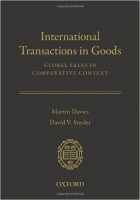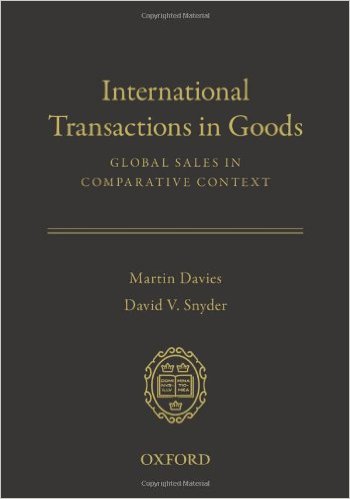 Authors: Martin Davies and David W. Snyder
Authors: Martin Davies and David W. Snyder
Publisher: Oxford University Press – 478 pages
Book Review by: Sonu Chandiram
In the world of international commerce, there are bound to be conflicts. Most of these are resolved amicably between buyer and seller. But when there are severe losses, written claims are made. Sometimes the claims are settled, while at other times, they remain unsettled and persist for a long time. In such instances, international trade laws are consulted, and the parties to the transaction, in order to save time, effort and money, settle between themselves.
But when there is absolutely no meeting of minds, the last resort is to file a lawsuit, especially when the loss is large. A basic question arises before lawsuits are begun: which country’s laws apply? If for example the selling (exporting) company is in China and the buying (importing) firm is in the United States, whose country’s laws apply, and to what extent? And which international trade laws are applicable? This book is your guide to such questions. Actual cases are presented, so you get a feel that this is not just a work in abstract form.
Many questions relating to international transactions are covered in the United Nations Convention on Contracts for the International Sales of Goods, known in short in the world of export-import as the CISG. But many more matters are not covered in detail in the CISG.
The authors begin with the assumption in the Preface that readers have at least some background in law and international sales, particularly with respect to:
- Civil law
- Common law
- International law
- The world of commerce
And for those who are currently exporting goods, or have at least exported goods for a few times in the past (in addition to selling them within the United States, for example) we trust that they are familiar with these basic documents – shown below – required for export of goods, at least with regards to export from the United States to other countries. We list the documents below in chronological order in the exporting process:
- Proforma Invoice
- Letter of Credit
- Invoice
- Packing List
- Certificate of Inspection
- Certificate of Origin
- Cargo Insurance Certificate / Policy
- Bill of Lading
- Payment by bank check or wire transfer
You can see, in picture form, the above transactional process on page 12 of the book, as well as samples of each the above documents in the pages of the Introduction.
The above topics – and much more – are covered in great detail in this very useful book on international transactions in goods. For export of services (rather than physical goods) some of the content in this book is also applicable. The materials in it are organized in the manner below. This gives you an idea of what is covered in this book, as well as what you will not find in it:
- An Introduction to International Sales and the Laws Governing Them
- Governing Law
- Negotiation, Formation, Terms, and Interpretation
- The Goods
- Delivery and Passing of Risk
- Payments, Credits, and Performance Guarantees
- Excused Performance When Circumstances Change
- Remedies
One of the highly useful features of this book is that the outline of content is very detailed. Under each of its eight chapters, you will subtopics, and further detail in two or more levels below.
So for example in chapter 4, The Goods, you will find eight subheadings, and nine sub-subheadings below them. In other chapters you will find topics under one more level.
Another very useful feature is excerpts of actual cases and how they were resolved. This is good for those who have experience in commerce but not in law. The authors themselves point out in their own words these advantages of using a real-world approach (rather than just a purely legalistic approach) in this book:
- The reader will want to practice law in the world of international sales
- The law is much easier to understand in this context
- Putting the law together with commercial and international dynamics – always changing, with different aspects acting on each other, leading to further changes in law, business, and the world – is among the most attractive and exciting parts of law practice in international commerce.
This is an important book to own and get familiar with, especially in today’s world where business between nations is on the rise, and there is no reason to stick to marketing and selling products within your own country (such as in the U.S. where there is increased competition) and be satisfied with limited sales volume, whereas you can generate much more revenue and profits for your company by opening up markets in other parts of the world.






